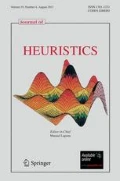Abstract
Many real life optimization problems are defined in terms of both hard and soft constraints, and qualitative conditional preferences. However, there is as yet no single framework for combined reasoning about these three kinds of information. In this paper we study how to exploit classical and soft constraint solvers for handling qualitative preference statements such as those captured by the CP-nets model. In particular, we show how hard constraints are sufficient to model the optimal outcomes of a possibly cyclic CP-net, and how soft constraints can faithfully approximate the semantics of acyclic conditional preference statements whilst improving the computational efficiency of reasoning about these statements.
Similar content being viewed by others
References
Bistarelli, S., H. Fargier, U. Montanari, F. Rossi, T. Schiex, and G. Verfaillie. (1996). “Semiring-Based CSPs and Valued CSPs: Basic Properties and Comparison.” In Over-Constrained Systems.
Bistarelli, S., U. Montanari, and F. Rossi. (1997). “Semiring-Based Constraint Solving and Optimization.” Journal of the ACM 44(2), 201–236.
Boutilier, C., R. Brafman, H. Hoos, and D. Poole. (1999). “Reasoning with Conditional Ceteris Paribus Preference Statements.” In Proc. of UAI, pp.71–80.
Boutilier, C., F. Bacchus, and R.I. Brafman. (2001). “UCP-Networks: A Directed Graphical Representation of Conditional Utilities.” In Proc. of UAI, pp.56–64.
Boutilier, C., R. Brafman, C. Domshlak, H. Hoos, and D. Poole. (2004). “CP-nets: A Tool for Representing and Reasoning about Conditional. ceteris paribus preference statements.” Journal of Artificial Intelligence Research (JAIR) 21, 135–191.
Boutilier, C., R. Brafman, C. Domshlak, H. Hoos, and D. Poole. (2004). “Preference-Based Constraint Optimization with CP-Nets.” Computational Intelligence 20(2), 137–157.
Brafman, R. and Y. Dimopoulos. (2004). “Extended Semantics and Optimization Algorithms for CP-Networks.” Computational Intelligence 20(2), 218–245.
Domshlak, C. and R. Brafman. (2002). “CP-Nets–-Reasoning and Consistency Testing.” In Proc. of KR, pp.121–132.
Domshlak, C., F. Rossi, K.B. Venable, and T. Walsh. (2003). “Reasoning About Soft Constraints and Conditional Preferences: Complexity Results and Approximation Techniques.” In Proc. of IJCAI, Acapulco, Mexico, August.
Doyle, J. and R.H. Thomason. (1999). “Background to Qualitative Decision Theory.” AI Magazine 20(2), 55–68.
Doyle, J. and M. Wellman. (1994). “Representing Preferences as Ceteris Paribus Comparatives.” In Proc. of AAAI Spring Symposium on Decision-Making Planning, pp.69–75.
Dubois, D., H. Fargier, and H. Prade. (1993). “The Calculus of Fuzzy Restrictions as A Basis for Flexible Constraint Satisfaction.” In Proc. of IEEE International Conference on Fuzzy Systems.
Fargier, H., J. Lang, and T. Schiex. (1993). “Selecting Preferred Solutions in Fuzzy Constraint Satisfaction Problems.” In Proc. of 1st European Congress on Fuzzy and Intelligent Technologies (EUFIT), pp.277–288.
Freuder, E.C. and R.J. Wallace. (1992). “Partial Constraint Satisfaction.” Artificial Intelligence 58(1–3), 21–70.
Garey, M.R. and D.S. Johnson. (1978). Computers and Intractability: A Guide to the Theory of NP-Completeness. W.H. Freeman and Company, New-York.
Goldsmith, J., J. Lang, M. Truszczynski, and N. Wilson. (2005). “The Computational Complexity of Dominance and Consistency in CP-Nets.” In Proc. of IJCAI.
Hansson, S.O. (2001). “Preference Logic.” In D.M. Gabbay and F. Guenthner, editors, Handbook of Philosophical Logic, volume 4, pp.319–394. Kluwer.
Lang, J. (2002). “From Preference Representation to Combinatorial Vote.” In Proc. of KR.
McGeachie, M. and J. Doyle. (2002). “Efficient Utility Functions for Ceteris Paribus Preferences.” In Proc. of AAAI, pp. 279–284.
Meseguer, P., F. Rossi, T. Schiex, and K.B. Venable. (2004). “Private Communication.” April.
Prestwich, S., F. Rossi, K.B. Venable, and T. Walsh. (2005). “Constraint-Based Preferential Optimization.” In Proc. of AAAI, Pittsburgh, Pennsylvania, July 9–13, Morgan Kaufmann.
Sabin, D. and R. Weigel. (1998). “Product Configuration Frameworks–-A Survey.” IEEE Intelligent Systems and their Applications 13(4), 42–49.
Schiex, T., H. Fargier, and G. Verfaille. (1995). “Valued Constraint Satisfaction Problems: Hard and Easy Problems.” In Proc. of IJCAI, pp. 631–637.
Schiex, T. (1992). “Possibilistic Constraint Satisfaction Problems,” or “How to Handle Soft Constraints?.” In Proc. of UAI, pp. 269–275.
Author information
Authors and Affiliations
Corresponding author
Additional information
This material is based in part upon works supported by the Science Foundation Ireland under Grant No. 00/PI.1/C075
Rights and permissions
About this article
Cite this article
Domshlak, C., Prestwich, S., Rossi, F. et al. Hard and soft constraints for reasoning about qualitative conditional preferences. J Heuristics 12, 263–285 (2006). https://doi.org/10.1007/s10732-006-7071-x
Issue Date:
DOI: https://doi.org/10.1007/s10732-006-7071-x




